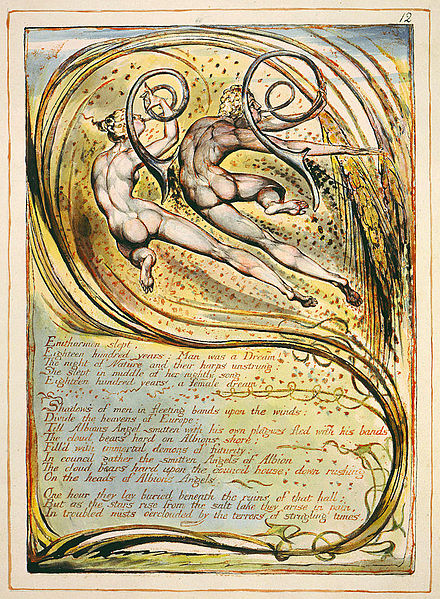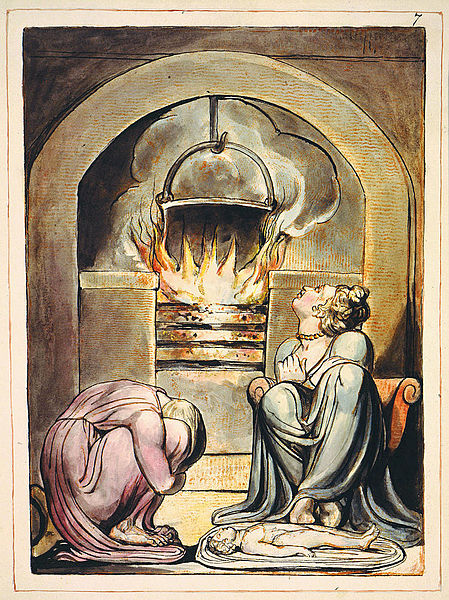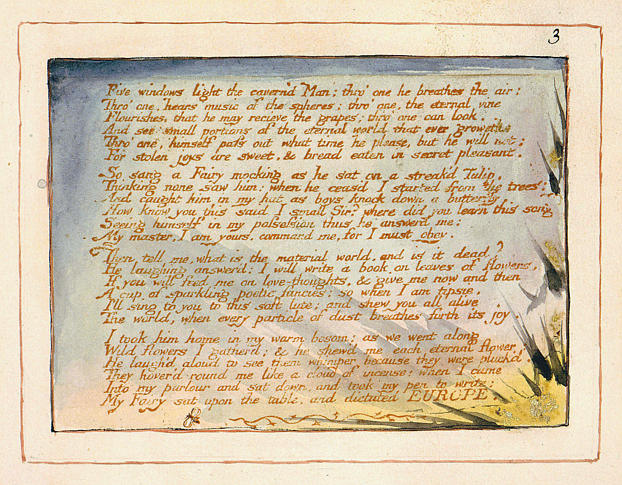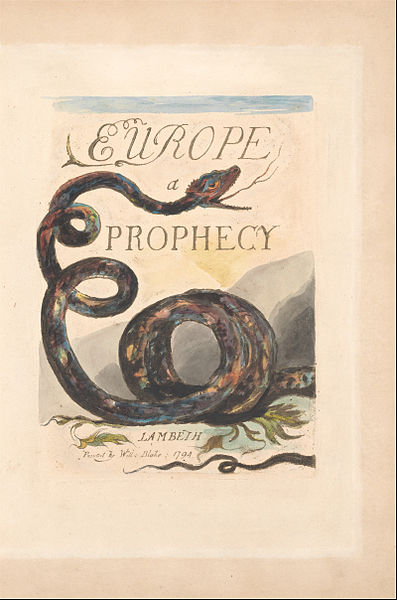In thoughts perturb'd, they rose from the bright ruins silent
following
The fiery King, who sought his ancient temple serpent-form'd
That stretches out its shady length along the Island white.
Round him roll'd his clouds of war; silent the Angel went,
Along the infinite shores of Thames to golden Verulam.
There stand the venerable porches that high-towering rear
Their oak-surrounded pillars, form'd of massy stones, uncut
With tool; stones precious; such eternal in the heavens,
Of colours twelve, few known on earth, give light in the opake,
Plac'd in the order of the stars, when the five senses whelm'd
In deluge o'er the earth-born man; then turn'd the fluxile eyes
Into two stationary orbs, concentrating all things.
The ever-varying spiral ascents to the heavens of heavens
Were bended downward; and the nostrils golden gates shut
Turn'd outward, barr'd and petrify'd against the infinite.
Thought chang'd the infinite to a serpent; that which pitieth:
To a devouring flame; and man fled from its face and hid
In forests of night; then all the eternal forests were divided
Into earths rolling in circles of space, that like an ocean
rush'd
And overwhelmed all except this finite wall of flesh.
Then was the serpent temple form'd, image of infinite
Shut up in finite revolutions, and man became an Angel;
Heaven a mighty circle turning; God a tyrant crown'd.
Now arriv'd the ancient Guardian at the southern porch,
That planted thick with trees of blackest leaf, & in a vale
Obscure, inclos'd the Stone of Night; oblique it stood, o'erhung
With purple flowers and berries red; image of that sweet south,
Once open to the heavens and elevated on the human neck,
Now overgrown ith hair and coverd with a stony roof,
Downward 'tis sunk beneath th' attractive north, that round the
feet
A raging whirlpool draws the dizzy enquirer to his grave:
(Erdman 63-4)
_-_Google_Art_Project.jpg) |
| Commons Wikipedia Europe 10 |
"they" are Albion's Angels, associating him with The fiery King.
ancient temple serpent-form'd: that of course is amply illustrated by
the left border of the Plate.
to golden Verulam: Verulam was where Francis Bacon lived; Blake loved to hate Bacon.
In the lines that follow Blake mentioned ancient temples going back to the Druids and beyond.
Thought chang'd the infinite to a serpent;
With the second paragraph Blake universalized the British scene to the World as we know it.
man became an Angel; Heaven a mighty circle turning; God a tyrant crown'd.
Now arriv'd the ancient Guardian at the southern porch, (research 4Z
and get an idea of the early (before the Fall) zoa in the South;
we have reason to believe that after the Fall it was Urizen.
We read about the the Stone of Night in a later Plate as
well as in America.
In this reading it appears that it refers to Urizen's skull.
(Look at plates 11-13 of the Book of Urizen.
For the Stone of Night look at page 387 of Damon's Blake Dictionary.
In the lines that follow Blake mentioned ancient temples going back to the Druids and beyond.
Thought chang'd the infinite to a serpent;
With the second paragraph Blake universalized the British scene to the World as we know it.
man became an Angel; Heaven a mighty circle turning; God a tyrant crown'd.
Now arriv'd the ancient Guardian at the southern porch, (research 4Z
and get an idea of the early (before the Fall) zoa in the South;
we have reason to believe that after the Fall it was Urizen.
We read about the the Stone of Night in a later Plate as
well as in America.
In this reading it appears that it refers to Urizen's skull.
(Look at plates 11-13 of the Book of Urizen.
For the Stone of Night look at page 387 of Damon's Blake Dictionary.
About the Image
The dominating figure is of course the reptile (Dragon?) with seven coils.
At the top it's mouth emits flames.
At the top it's mouth emits flames.
From Works we learn that
"This is probably the serpent-form of Orc, the spirit of revolution,
although a more immediate textual context on this plate appears in line 18:
"Thought chang'd the infinite to a serpent."
although a more immediate textual context on this plate appears in line 18:
"Thought chang'd the infinite to a serpent."











No comments: